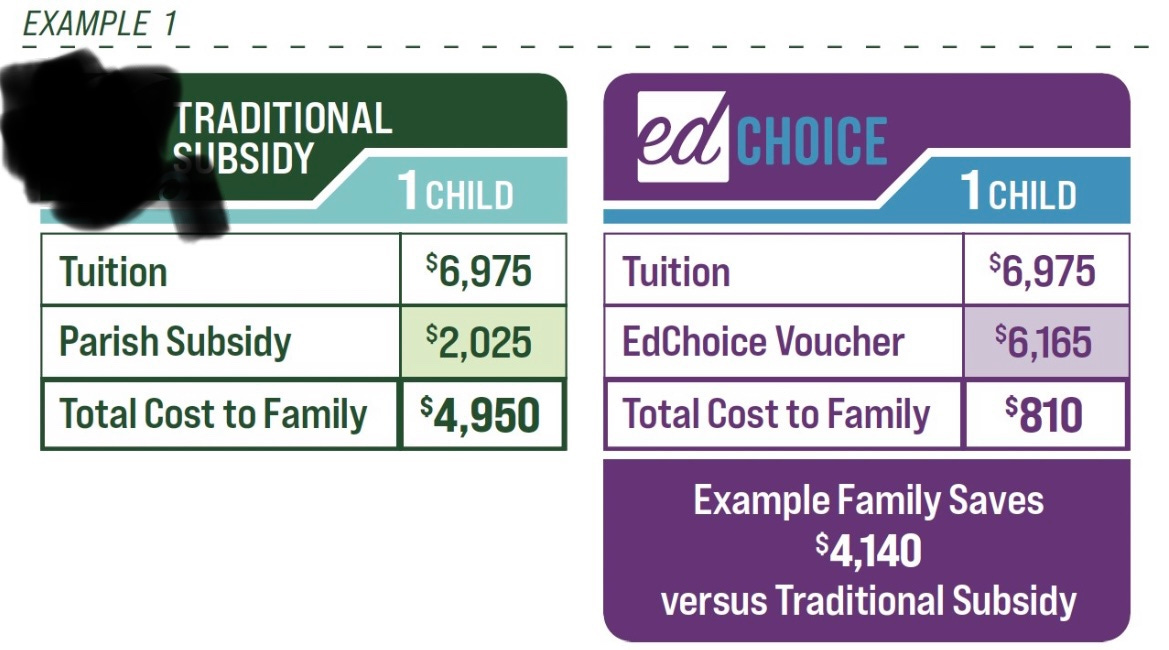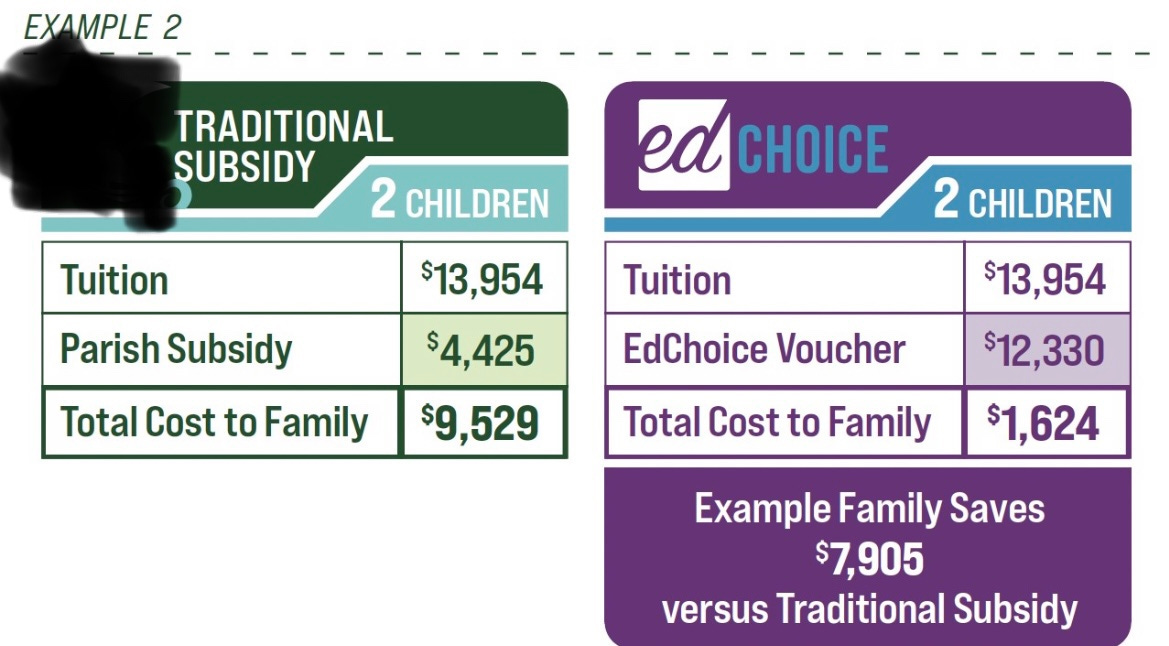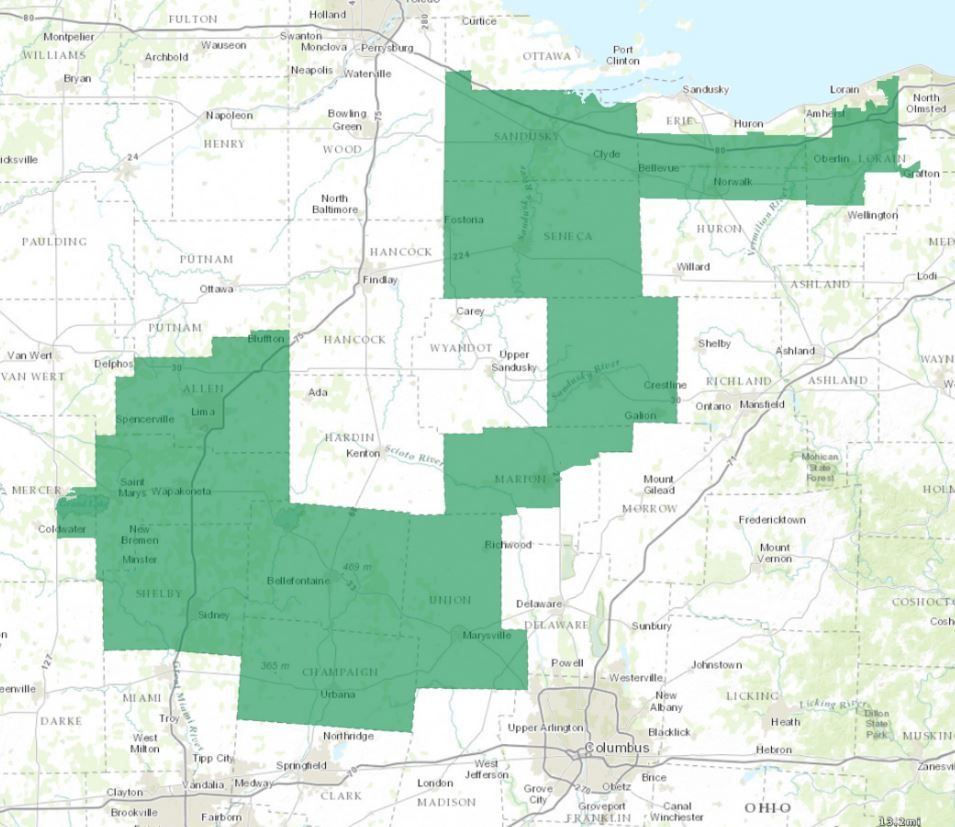Read and watch more of David's excellent work at Pepperspectives.
By David Pepper
“Dear School Parents…”
The letter starts innocently enough. A letter from a school official to that school’s parents, announcing some big news.
But within a few sentences, the content will take your breath away. It did mine when I first saw it:
“The recent approval and expansion of EdChoice is a tremendous boon to our school families and Catholic education across Ohio. While its implementation will be a challenging process, we are abundantly blessed by the opportunities and savings it presents for all of us.”
As if the “savings” emphasis was not already clear enough, the letter doubles down: “most families will be saving more money than ever on their child's Catholic education at [school].”
The author next encourages all families to seize the cost-saving opportunity: “Every family is strongly encouraged to apply for and receive the EdChoice scholarship…. Depending on your income level, you will receive up to $6,165 from the State. Even a small scholarship is a major blessing for you, the school, and the parish.”
“The landmark and unprecedented support from EdChoice will serve as the new 'universal' subsidization of your child's education costs.”
As if the letter has not already made it clear that “every” family should apply for the state money, not doing so will result in a meeting: “Please note: If a family elects to not apply for the universal EdChoice scholarship available to them, we will respect that decision. Supplemental financial aid from the parish in this case will require a meeting with [X] before being awarded.”
And just to be sure families understand the “savings” coming their way: “The next page illustrates examples of how tuition payments will look this year with EdChoice scholarships. The expansion of EdChoice is a remarkable gift to all of us…and should truly be celebrated as such.”
“Sincerely, Father [X]”
As promised, on the next page, the following tables are presented, laying out the enormous cost savings thanks to the new “gift” from the State of Ohio. Look at them closely:


EdChoice is the name of the Ohio school voucher program the letter is describing, which in recent years has been put on steroids by the Ohio statehouse. And in its simplicity and transparency, the above letter (I first learned of it in an email sent by the Ohio Coalition of Equity and Adequacy of School Funding) reveals the dramatic changes that—my guess is—almost no Ohioans understand have taken place, even as we fund it all.
Those changes have converted a program that was once sold to the public with a narrow, specific purpose, and dramatically reshaped it so it looks nothing like that original sales pitch, and nothing like how most people envision it today.
Given the consequences as well as the fact that we’re all paying for it, every Ohioan must understand what’s happening.
But this goes way beyond Ohio.
Every American should know this story as well—because what’s happening in the Buckeye State is happening in red states across the country. It’s a national playbook.
So with the letter doing most of the talking, let’s walk through some specifics:
Note that the letter doesn’t once tout the choices it presents to families to choose to come to the school. Instead, it touts the “savings it presents for all of us”—“us” meaning families at the school.
Yes, it’s a letter addressed to families already at the school: “[M]ost families will be saving more money than ever on their child's Catholic education.”
This doesn’t sound like a letter to a bunch of newcomers, does it?
This already may have you wondering, as it did me: but I thought the whole point of the voucher experiment and so-called “school” choice was to help those in so-called “poor” public schools choose to go elsewhere? That’s how it’s been sold to the public for years, in Ohio and other states.
But this letter leaves the distinct impression that Ohio’s EdChoice program benefits families who have already chosen this private school—who hadn’t previously been at a different school at all. The best savings “ever,” suggesting continuity.
And that impression is left because that’s exactly what the EdChoice program now does, by design!
Several years ago, the state began to phase out the previous, long-time requirement that to be eligible for new state voucher support, a student must have attended a public school in the prior year. So while the original justification of vouchers was to help students “choose” to leave a poor performing public school, now a student receives a voucher even if they never set foot in that public school. Yes—even if they’ve gone to the private school the entire time.
As you’d expect, data show that the phase-out of this requirement is having a dramatic impact across the state. While in 2018, 3.6% of Grade 9-12 EdChoice new voucher recipients had not attended a public school in the prior year, in 2022, that number had leapt to 66.6%! That’s right—Ohio vouchers now are largely going to students who were already attending those private schools.
Bottom line: As one expert wrote, “[y]ou're just paying for people that have already demonstrated that they have the ability to make that choice themselves.”
Not anymore!
The most recent Ohio budget eliminated the requirement that vouchers go to families who live in low-performing public school districts. So vouchers are no longer about school performance at all, which we were all told at the outset was the entire point!
This, of course, only adds to the likelihood that many students are receiving tax dollars to attend private schools (which are far less regulated and publicly accountable than public schools) that are worse than the public schools in their community. And studies show that that theoretical likelihood is playing out just as feared in the real world, especially in Ohio:
“For the few kids who did use vouchers to leave public schools, their test score drops are between -0.15 and -0.50 standard deviations. That’s almost unprecedented. As a comparison, we have to look to education policy but to natural disasters to find a similar loss. On the low end of that range is the academic loss suffered by New Orleans kids after Hurricane Katrina. On the middle end is about what COVID19 did, on average, to student growth rates. In Louisiana, Ohio—where those harmful voucher effects approach half a negative standard deviation—the loss is almost twice the pandemic’s academic impact.”
Bottom line: Ohio vouchers are no longer about helping kids in underperforming schools move to better schools. To the contrary, data show that vouchers, on average, are subsidizing kids going to schools where they end up performing worse academically!
The tone of the letter is striking in one other way. Throughout, it frames the EdChoice program as one of “savings” to families. And as the chart shows, the new “gift” from the state “saves” families a sizeable amount of money.
Usually, when scholarships make the difference between attending and not attending an institution, you don’t see them referred to as simply “savings.” That scholarship makes all the difference between whether or not a student can attend in the first place. It bridges the gap—it makes “the choice” possible.
But here, it’s all about savings—“saving more money than ever.” Feels more like a coupon, doesn’t it?
Why?
Because for most recipients, that’s the role this taxpayer money serves.
And that’s because under other changes made to the EdChoice program, the lion’s share of the recipients are not low-income families at all. They can already afford the price of the school. So the “gift” from the state ends up serving as “savings” for the cost of a private school they already attended and paid for—and not as a bridge that allows them to afford that school in the first place.
The letter gives this all away, when it urges “every family” to apply for the EdChoice scholarship—regardless of their means. Every family, because everyone is now eligible regardless of income!
Again, this is by design:
The latest alterations to Ohio’s EdChoice program makes any family up to 450%(!) the poverty level eligible for the FULL voucher amount (more than 6,000 for each child). And 450% equals any family of four that makes up to $135,000. How many school-age kids are in families that fit into that category? 74% of them.
But it doesn’t stop there. Families that make even more than that are still eligible for partial scholarships. Thousands of dollars per child.
There is no upper limit on eligibility.
And again, no surprise, even though it’s a newer feature, removing income limitations has dramatically changed the makeup of who’s receiving these state vouchers across Ohio. Ten years ago, 37% of Cleveland vouchers recipients were in low-income families; that number had fallen to 7.1% by this year. Statewide EdChoice recipients were 31.8% low-income in 2015; by 2023, the number had fallen to 14.9%.
So the reason that the letter refers to the EdChoice program as “saving,” like a coupon, is because for most receiving the letter, that’s exactly what it is. These are families who 1) already were sending their kids to the school; and 2) are largely not in the low-income range—many live comfortably in at least the middle class, and even high-income families cash in. For most, the “remarkable gift” from Ohio legislators will save them thousands of dollars for decisions they have already made and which they already could afford.
Remember, “every family” can get in on the savings.
And all of this helps explain what, to me, is the most striking sentence of the entire letter: that, for this and other schools, the “remarkable gift” from Ohio serves as the “universal subsidization” of a private, religious education that the school had already been providing to countless families who could already afford it.
That universal subsidization of private education is now happening statewide. And in many other states as well.
Add it all up, and this letter and data paint a dramatically different picture than something that began—and as has always been framed—as something to help poor students “escape” from underperforming public districts. As one long-time Ohio columnist wrote: “What began over 20 years ago as a $5 million pilot project in Cleveland to rescue low-income families from “failing schools” and give their kids a better alternative, rapidly morphed into public giveaways (of hundreds of millions of dollars) to subsidize the private education of affluent families in high-achieving school districts whose kids never set foot in public schools.”
Without meaning to be, the letter above is as honest a presentation of exactly what has happened than any document I’ve seen. Think about its key sentences in light of all the data I shared:
Having attended a Catholic school for part of my own education, I don’t want what I’m presenting here to be misinterpreted. These schools can and do provide invaluable educations in communities across Ohio. And they serve as essential centers of community in so many ways.
But this letter and the data I’ve shared are about the expenditure of public taxpayer dollars for education—a function guaranteed in the Ohio Constitution. That's the issue, and the letter opens up enormous questions about how those dollars are being used:
In sum, all of these items pose enormous questions.
And after watching Ohio’s current leaders operate for years, I have zero faith they will approach any of these questions responsibly. In fact, since I began drafting this newsletter, further bad news came down that the state is now able to move forward with the removal of most of the powers from the Ohio School Board—a public body which includes directly elected members—to a Governor’s bureaucracy with no checks and balances. Which means discussion and decisions over these key issues (and others) were just sent even further behind closed doors. In a state already considered one of America’s most corrupt, that will never end well.
But put all those questions aside for a moment: the main point of this newsletter was simply to explain what the Ohio voucher program has become—and how it is now operating: as “universal subsidization” of private schools.
My suspicion is most people who are paying for it and impacted by it have absolutely no idea.
And if we’re ever going to fix it, in Ohio and all the other states where this is happening, that’s the first thing that must change!







